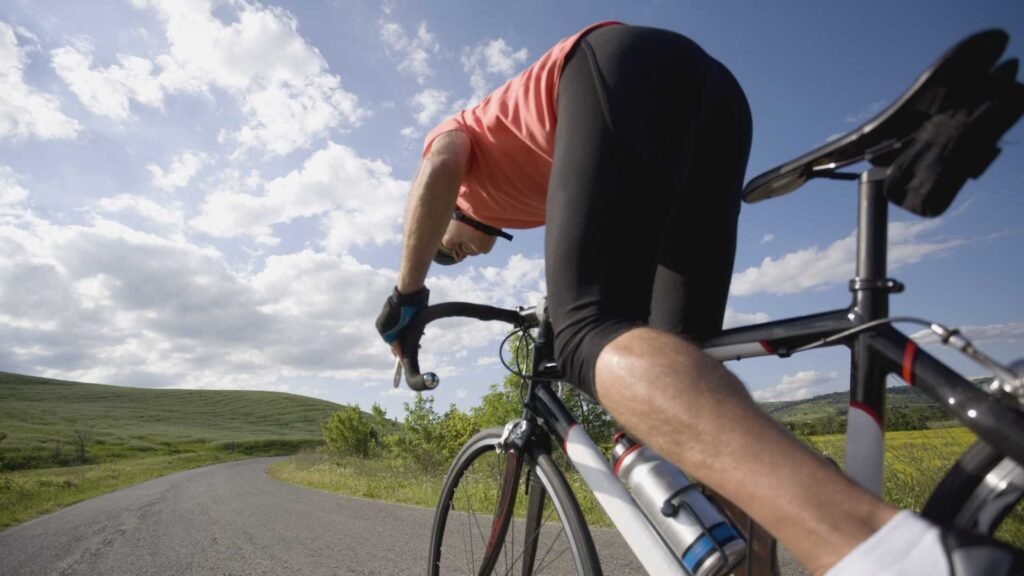When someone asks me how long should I ride a bike to lose belly fat, my answer is simple — you can lose it, 100%, but you’ll have to ride constantly for 6 weeks, that too with good intensity.
Most people think just cycling for a few minutes will melt belly fat, but it doesn’t work like that.
Belly fat is stubborn; it takes regular effort, patience, and the right balance of riding time and food habits.
Can You Really Lose Belly Fat by Cycling?

Yes, you can. I have personally seen people losing belly fat just by biking regularly, but the key thing here is “regularly.”
Cycling is one of the best cardio exercises that can burn a lot of calories in a short period of time, and when you ride longer or at higher intensity, your body will start using stored fat for energy.
And that’s how you start losing belly fat — not just from your stomach, but from your whole body.
Now, you might think that only long-distance cycling works.
So, it’s not about the distance, it’s about how long and how hard you ride.
If you’re riding casually for 10 minutes a day, you might not burn much.
But if you’re doing 30 to 60 minutes of proper biking, and doing it 4 to 6 days a week, then yes — you’ll start seeing a difference in a few weeks.
You can also read What Happens If You Bike Every Day for 30 Minutes — which explains what changes happen in your body and mind if you ride daily.
How Long Should You Ride To Burn Belly Fat
If your goal is to burn belly fat, you should ride a mountain bike or cycle at least 30–60 minutes every day.
Now, here’s how you can plan it:
- Beginners: You can start with 25 to 30 minutes daily, moderate pace, focus on habit building.
- Intermediate riders: Ride 45 to 60 minutes per session, at least 4 to 5 times a week.
- Advanced riders: 60 to 90 minutes with intervals or hill rides for faster results.
Your main goal shouldn’t be going too fast from day one, but to stay consistent.
Even if you ride 30 minutes daily, your body starts burning calories and fat after the first 15 minutes.
That’s because, for the first few minutes, your body will use glycogen (carbs), and after that, your body will switch to fat as a source of energy.
If you can extend your ride to 45 minutes, you’ll burn more fat.
But if you can go even longer — like an hour — that’s where the magic happens.
When I wanted to drop my overall fat.
I used to ride my mountain bike for 45 to 60 minutes in the evening, 4–5 days a week.
I also did some Core Strength Training for Mountain Bikers twice a week — and that combination gave me quick results.
Why 30 to 60 Minutes Works the Best
There’s a reason why I say 30 to 60 minutes is the sweet spot for fat loss through biking.
Your body needs time to warm up and get your heart rate into the fat-burning zone (around 60 to 75% of your maximum heart rate).
If you ride for only 10–15 minutes, you’re not really reaching that zone for long enough.
But if you’re riding for half an hour or more, your body spends more time burning fat efficiently.
It also depends on how fast you ride. For example:
- 30 minutes of moderate biking can burn 250–350 calories.
- 60 minutes of higher intensity biking can burn 500–700 calories, depending on your weight.
And if you ride uphill or on a trail, you’ll burn even more.
If you want to improve your endurance and stamina, check this detailed guide — 9 Effective Ways to Build Stamina for Longer Mountain Bike Rides.
Ride Intensity Matters More Than Distance

It’s not just about how long you ride but also how intense your ride is.
If you’re biking very slowly while scrolling your phone, you won’t burn much.
But if you’re pushing yourself. You have to increase your cadence, maintain a good pace, and ride with focus.
That way, your body will start burning fat faster.
I recommend this:
- Keep your effort level at 6 to 7 out of 10 for most of your ride.
- You should be breathing heavy but still able to talk.
- Add some short bursts of higher effort (sprints or hill climbs).
For example: you can ride 3 minutes fast, 2 minutes easy — repeat 6 to 8 times.
That’s how you make your cycling sessions more powerful for fat loss.
This type of interval training also increases your endurance and stamina. You can also learn more in this article: Mountain Bike Endurance Training.
Terrain Also Changes Everything

If you’re riding on a flat road every day, that’s fine. But if you really want to lose fat faster, try adding a few hill rides or mountain trails.
When you ride uphill, your legs and core work harder, and you end up burning more calories in less time.
Even on technical trails where you have to balance your bike, your core muscles stay engaged the entire time, which directly helps tone your belly.
You can explore some Scenic Mountain Bike Trails or even Local Mountain Bike Trails if you want a change of scenery, because when rides are fun, you automatically stay consistent.
Combine Cycling with a Clean Diet

No matter how long you ride, if your diet is not right, you won’t lose belly fat.
I’ve seen riders doing 1-hour rides daily, but they still eat too much junk afterward, which cancels all progress.
So if your goal is fat loss, keep your diet clean and simple:
- You should eat lean protein (chicken, eggs, tofu, fish).
- Add complex carbs (no baked chocolate oats, rice, sweet potato).
- Avoid sugar drinks and processed foods.
- Drink enough water during and after rides.
- Eat more fiber — it keeps you full longer.
If you want to plan it better, you can read my guide on Exercises for Mountain Biking, where I also discuss nutrition briefly.
Ride Frequency — How Many Days a Week
If you can ride 4–6 times a week, that’s perfect.
The goal is to burn more calories than you consume and to stay active almost every day.
If you are a beginner, even 3–4 rides per week can help. Once your body adapts, you can increase it to 5–6 rides a week.
And take at least 1 rest day — that’s when your muscles recover and rebuild. Without recovery, you’ll burn out and start feeling fatigued, which will slow your progress.
Read What Is the Best Age to Start Mountain Biking if you think you’re too late or too old to begin — because you’re not.
Add Core Workouts to Target Belly Fat
Cycling itself will strengthen your core, but if you could add a few core exercises on non-riding days, it will double your results.
You don’t have to go to the gym — you can do them at home easily:
- Planks (3 sets of 30–60 seconds)
- Russian twists
- Mountain climbers
- Leg raises
All these will engage your stomach muscles and make your core tighter.
Check this post on Core Strength for Mountain Biking — it’s perfect if you want to make your abs stronger while improving your biking control.
Common Mistakes When Trying to Lose Belly Fat by Biking
Here are the most common mistakes I see:
- Inconsistency: If you are riding 2 days, skipping 3 days, it won’t help you lose belly fat.
- Overeating – You can’t out-train a bad diet.
- Too much low-intensity riding: You must push harder sometimes.
- No rest: Your body will burn fat better when well-rested.
- No progression: You must slowly increase your ride duration or intensity weekly.
- Wrong bike setup: A wrong fit can limit your ride time.
Before every long ride, check your brakes, chain, and tire pressure using this Mountain Bike Pre-Ride Checklist.
Morning vs Evening Riding — What’s Better?
I’ve done both, and honestly, both have their own benefits.
- Morning rides: It will help you boost metabolism early in the day and burn stored fat faster if you go on an empty stomach.
- Evening rides: It will help release stress after work and is perfect if you’ve eaten properly throughout the day.
But what really matters is that you ride at all. Don’t skip rides just because you couldn’t do it at a specific time.
How to Keep Yourself Motivated
I know some days you’ll feel lazy or demotivated, especially after 5-6 days, cause you won’t really see results here, as it happens to everyone.
But here’s what you do to keep yourself motivated:
- You can track every ride using Strava, and when you see progress, it will keep you motivated.
- You can keep changing trails every few weeks to avoid boredom.
- You can also ride with friends or groups and make your ride fun.
- You can just follow a simple plan and stick to it.
If you ever lose motivation, read Starting Mountain Bike at 40: 10 Tips to Follow — it’ll remind you that it’s never too late to start anything new.
Example Weekly Plan for Belly Fat Loss

You can follow this simple plan. Or you can also customize as per your timing, needs, or habit.
- Monday: 45-minute steady ride
- Tuesday: 30-minute interval ride (HIIT)
- Wednesday: Rest or 20-minute recovery spin
- Thursday: 60-minute steady endurance ride
- Friday: 30-minute hill ride or high intensity
- Saturday: 75–90 minute long ride
- Sunday: Rest
This combination will work best for both fat loss and stamina. You can even adjust it based on your schedule.
If you’re confused about what bike setup to use, check Clipless vs Flat Pedals — it’ll help you choose pedals that fit your riding style better.
Final Motivation Before You Start
Look, losing belly fat will take time — there’s no magic shortcut that I can tell you.
But if you stay consistent with cycling and keep your food habits in control, the results are guaranteed.
I’ve seen it personally. Even if you’re 40 or 50, cycling daily for 30–60 minutes can transform your body.
It will not just improve how you look but also how you feel, like more energy, a better mood, stronger legs, and better sleep.
And that’s what fitness is about.
So, start today, even if it’s for 20 minutes, ride.
Just keep going, keep pushing, and within a few weeks, you’ll see the difference in your mirror.

Ali is the founder of Mountain Bike Insider and an passionate rider with years of hands-on experience in mountain biking. From testing gear to exploring trails, Ali writes based on real riding knowledge to help others make smart, safe, and enjoyable biking choices. Every guide is built on research, personal use, and a passion for the sport.







